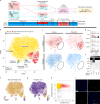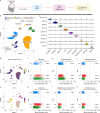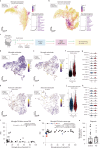Dissection of artifactual and confounding glial signatures by single-cell sequencing of mouse and human brain
- PMID: 35260865
- PMCID: PMC11645269
- DOI: 10.1038/s41593-022-01022-8
Dissection of artifactual and confounding glial signatures by single-cell sequencing of mouse and human brain
Erratum in
-
Author Correction: Dissection of artifactual and confounding glial signatures by single-cell sequencing of mouse and human brain.Nat Neurosci. 2025 Jan;28(1):215. doi: 10.1038/s41593-024-01855-5. Nat Neurosci. 2025. PMID: 39672966 Free PMC article. No abstract available.
Abstract
A key aspect of nearly all single-cell sequencing experiments is dissociation of intact tissues into single-cell suspensions. While many protocols have been optimized for optimal cell yield, they have often overlooked the effects that dissociation can have on ex vivo gene expression. Here, we demonstrate that use of enzymatic dissociation on brain tissue induces an aberrant ex vivo gene expression signature, most prominently in microglia, which is prevalent in published literature and can substantially confound downstream analyses. To address this issue, we present a rigorously validated protocol that preserves both in vivo transcriptional profiles and cell-type diversity and yield across tissue types and species. We also identify a similar signature in postmortem human brain single-nucleus RNA-sequencing datasets, and show that this signature is induced in freshly isolated human tissue by exposure to elevated temperatures ex vivo. Together, our results provide a methodological solution for preventing artifactual gene expression changes during fresh tissue digestion and a reference for future deeper analysis of the potential confounding states present in postmortem human samples.
© 2022. The Author(s), under exclusive licence to Springer Nature America, Inc.
Conflict of interest statement
The authors declare no competing interests. Though we believe that none of these relationships are conflicts of interest, D.A.H. has received research funding from Bristol Myers Squibb, Sanofi and Genentech for work unrelated to this project. He has been a consultant over the past 10 years for Bristol Myers Squibb, Compass Therapeutics, EMD Serono, Genentech, Juno Therapeutics, Novartis Pharmaceuticals, Proclara Biosciences, Sage Therapeutics and Sanofi Genzyme.
Figures




References
-
- Svensson, V., Vento-Tormo, R. & Teichmann, S. A. Exponential scaling of single-cell RNA-seq in the past decade. Nat. Protoc.13, 599–604 (2018). - PubMed
-
- Abuzakouk, M., Feighery, C. & O’Farrelly, C. Collagenase and Dispase enzymes disrupt lymphocyte surface molecules. J. Immunol. Methods194, 211–216 (1996). - PubMed
-
- Cardona, A. E., Huang, D., Sasse, M. E. & Ransohoff, R. M. Isolation of murine microglial cells for RNA analysis or flow cytometry. Nat. Protoc.1, 1947–1951 (2006). - PubMed
-
- Grange, C. et al. Phenotypic characterization and functional analysis of human tumor immune infiltration after mechanical and enzymatic disaggregation. J. Immunol. Methods372, 119–126 (2011). - PubMed
Publication types
MeSH terms
Grants and funding
- U01 AG046152/AG/NIA NIH HHS/United States
- 203151/Z/16/Z/WT_/Wellcome Trust/United Kingdom
- R01 AG030146/AG/NIA NIH HHS/United States
- R01 AG017917/AG/NIA NIH HHS/United States
- MRC_/Medical Research Council/United Kingdom
- RC2 AG036547/AG/NIA NIH HHS/United States
- R01 AG048015/AG/NIA NIH HHS/United States
- U01 AG061356/AG/NIA NIH HHS/United States
- U01 AG032984/AG/NIA NIH HHS/United States
- R01 AG036042/AG/NIA NIH HHS/United States
- P30 AG010161/AG/NIA NIH HHS/United States
- RF1 AG057473/AG/NIA NIH HHS/United States
- T32 GM008313/GM/NIGMS NIH HHS/United States
- U01 AG046161/AG/NIA NIH HHS/United States
- WT_/Wellcome Trust/United Kingdom
- R01 AG036836/AG/NIA NIH HHS/United States
- R01 AG015819/AG/NIA NIH HHS/United States
LinkOut - more resources
Full Text Sources
Molecular Biology Databases

